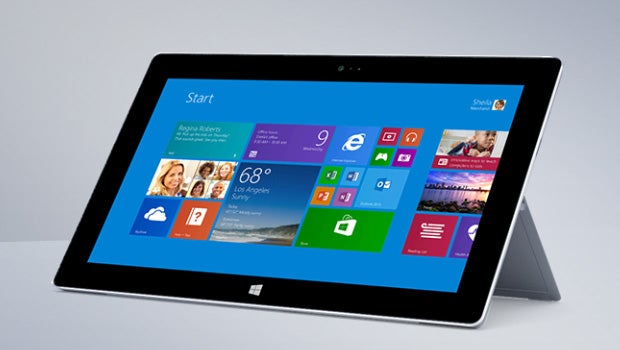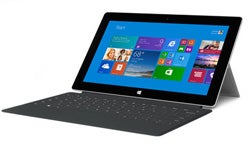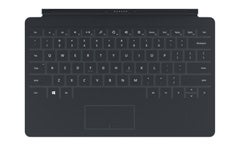Surface Pro 2 vs Surface Pro – What is different?

Microsoft has launched the second wave of Surface tablet devices. The Surface Pro 2 and Surface 2 take what the originals had and add a lot more besides.
Here’s how the more expensive – and more capable – of the two, the Microsoft Surface Pro 2, compares to its predecessor.
Intel Haswell is here
The most important upgrade in the second-generation Microsoft Surface Pro 2 tablet is that it uses the latest generation of Intel processor.
Where the first Surface Pro used an Ivy Bridge processor, the Pro 2 has a Haswell system on chip setup. It’s an Intel Core i5 dual-core 1.6GHz processor with an HD 4400 graphics chip. The first-gen model uses a lesser HD 4000 GPU.
The Surface Pro 2 is a good deal more powerful than the first-generation model, and is significantly better as a gaming tablet – although don’t expect to play the latest games on the thing.
The Surface Pro 2 has either 4GB or 8GB of RAM too, where the first-gen model tops-out at 4GB.
… which means battery life is better
 Aside from increased performance, the Haswell generation of chips also offers better battery efficiency. Microsoft says battery life is ‘up to 75 per cent’ longer than the first Surface Pro – although other sources are also reporting a 60 per cent increase.
Aside from increased performance, the Haswell generation of chips also offers better battery efficiency. Microsoft says battery life is ‘up to 75 per cent’ longer than the first Surface Pro – although other sources are also reporting a 60 per cent increase.
In our tests, the first Surface Pro lasted for four hours and five minutes. Add the claimed battery improvement and we’re looking at seven solid hours of proper productivity performance. Of course, we don’t know whether that figure relates to this sort of task – although if we don’t get at least six and a half hours out of the thing we’ll be pretty miffed.
The display is better too
Specs of the new Surface Pro 2 screen haven’t altered from the first model. It’s a 10.6-inch 1080p screen using an IPS-style panel.
Microsoft claims that its colour accuracy is 46 per cent better this time around, implying that either Microsoft is using a different panel supplier, a slightly tweaked panel, or that it’s paying closer attention to display calibration. Either way, it’s a good thing.
Maximum storage is up to 512GB
There are also more configurations of the Surface Pro 2 planned. Where the first version launched with 64GB and 128GB storage capacities, the new version will go all the way up to 512GB.
No hard drives are involved here. It’s all Flash-based storage. That means it’ll be quick, but not cheap.
The 512GB model only comes with 8GB of RAM (as opposed to 4GB), and will set you back £1439. When the entry-level version costs ‘just’ £719, you’ll need full pockets to justify the extra expense.
The kickstand has been redesigned
One of the defining hardware bits of the original Surface was the kickstand. The kickstand makes a return in the second version, but this time around it can rest in two positions, rather than just one.
As well as stand standard ‘laptop-like’ display orientation, you can make the Pro 2 lean back a bit further, making it more comfortable to use on your knees – especially in cramped conditions.
It has graphics tablet capabilities from the off
Although not discussed all that much, the first Surface Pro had a Wacom digitiser layer – similar to the type used in professional graphics tablets. The stylus bundled with the Surface Pro wasn’t hugely capable from the off despite being technologically sound because its software didn’t support pressure sensitivity for Photoshop and other popular artist’s programs. The Surface Pro 2 starts with this support from day one.
It’s not new as such, but shows that the Pro 2 launches as a more complete-feeling product.
And a backlit keyboard case is available
 One of the most striking things about the original Surface line-up was the array of keyboard cases available for the things. There was a clicky-button keyboard and one with non-moving keys that was surprisingly good (after all, it sounds awful doesn’t it?)
One of the most striking things about the original Surface line-up was the array of keyboard cases available for the things. There was a clicky-button keyboard and one with non-moving keys that was surprisingly good (after all, it sounds awful doesn’t it?)
This second wave of Surfaces sees three models added to the squad. There’s a Power Cover that uses the clicky keyboard and incorporates a battery. There’s also the Type Cover 2, a backlit keyboard that has clicky keys but is almost as thin as the original non-clicky cover. Key travel will be shallower, but it’s super super slim.
The third case is the Touch Cover 2, which uses non-moving skinny keys. It too is backlit and is far smarter than the original. Where the original Touch Cover keyboard used 80 sensors, the Touch Cover 2 has 1,092 sensors. It’ll be more accurate than before (and it wasn’t too shabby first time around), and allow you to use gestures across the keyboard, making it a full touch surface. It’s possible you’ll be able to use the whole surface of the keyboard as a giant trackpad.
Supporting this idea, there’s a Bluetooth wireless adapter for the Touch Cover 2, letting you use it more comfortable while lounging – although it can be used with any of the new keyboard covers.
They also ship with Windows 8.1
This one is hardly a biggie, but the Surface Pro 2 will ship with Windows 8.1. It’s a free update, one that owners of the original Surface Pro will be able to download. Differences include the return of the Start bar, and a ‘boot to desktop’ mode that’ll make it feel a lot more like Windows 7 – perfct if you’re going to use the thing more like a laptop than a tablet.
Early verdict
The second Surface Pro isn’t a revelation. It’s a tweaked and improved version that will look and feel a good deal like the first. However, the extra power and hugely improved battery life mean it’s much more important than most generational shifts in rival Android tablets.
Next, read our review of the top-notch budget Samsung Ativ Book 9 Lite laptop


